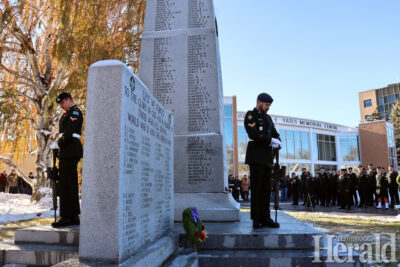Remembrance Day a vigil of honour
By Lethbridge Herald on November 11, 2022.
 Members of the 20th Independent Field Battery stand on vigil at the Cenotaph during Friday's Remembrance Day ceremony.
Herald photo by Al Beeber
Members of the 20th Independent Field Battery stand on vigil at the Cenotaph during Friday's Remembrance Day ceremony.
Herald photo by Al BeeberCal Braid – LETHBRIDGE HERALD – Local Journalism Initiative Reporter
In a stirring Remembrance Day ceremony, hundreds packed the square in front of the Yates Memorial Theatre to honor Canadian soldiers who never returned home from war. The Cenotaph in the square is a memorial for those soldiers whose loved ones were denied the opportunity to bury their dead.
Master of Ceremonies, 2nd Lieutenant Matthew McHugh, said, “Following the First World War, most people were unable to travel to France. Cenotaphs like ours here in Lethbridge were built all across Canada in towns and cities to commemorate the over 53,000 Canadian soldiers who were killed in action and whose remains were never found or never returned to Canada. At the cenotaph we stand guard by way of vigil.”
He said for many Canadian families, no funeral rites could be completed for loved ones lost on the battlefield of the First World War, “So each year on Remembrance Day, we gather in front of the cenotaph to stand guard for our lost warriors whose funeral rites were never completed.”
McHugh explained that on Nov. 11, 1918, the armistice was signed to end what was known as ‘the war to end all wars.’ He said many allied countries recognize the sacrifices made by their veterans in the First World War and all wars since then by observing a symbolic ceremony that contains a Last Post, Two Minute Silence, Lament, and the Rouse.
“The Last Post is played to summon the spirits of the fallen to the cenotaph,” he said. “It was originally played to signal to soldiers the camp was secure for the night. It was also played to call out to wounded or separated soldiers at the end of a battle in order to guide them home to safety and rest. Today, it signifies that a soldier’s last sentry duty is finished; he or she has died and we’re calling home the spirits of the fallen to rest.”
Remembrance Day ceremonies call for two minutes of silence on the eleventh hour of the eleventh day of the eleventh month, as a symbol of honor and gratitude. McHugh said, “The first minute of silence is for those who died in the war, the second minute is for those who were left behind (and) deeply affected by the conflict.”
The Lament is played by a bagpiper and is an expression of grief and mourning. Historically, it symbolizes the sounds of spouses and children crying over their dead. “It symbolizes our collective sorrow,” he said. “The Rouse is played at the end of the two minutes of silence. The Rouse was originally used to wake up soldiers every morning. In this ceremony, the Rouse is used to wake the fallen soldiers (to) rise above their mortal duties on earth so they may rest in peace.”
McHugh then called out, “Vigil Commander, Mount Vigil,” and Master Bombardier Tyson Penrod led a group of soldiers to march and then stop before the cenotaph before four of them took place at each corner with their heads bowed and rifles lowered vertically to the ground. Sara Folden was called upon to sing O Canada, and Ken Lewis followed with the Last Post on trumpet. The Two Minute Silence ensued, piper John Gray played the Lament, and then Lewis performed the Rouse.
An overhead fly-past was performed by the Royal Canadian Air Force C-17 Globemaster from 429 (Bison) Squadron, as well as a Harvard MK IV aircraft, piloted by Geoffrey Brayne. McHugh read the Act of Remembrance and Guest speaker, Major Robert Mein, Commanding Officer 20th Independent Field Battery, then talked briefly. Incoming Honorary Lieutenant Colonel Dory Rossiter laid a wreath at the foot of the cenotaph on behalf of all the bereaved mothers across Canada. Outgoing Honorary Lieutenant Colonel Rick Casson laid a second wreath at the base of the cenotaph and Captain Luke Watson gave the Benediction.
11-10


